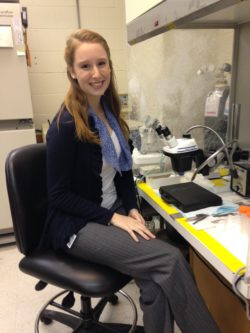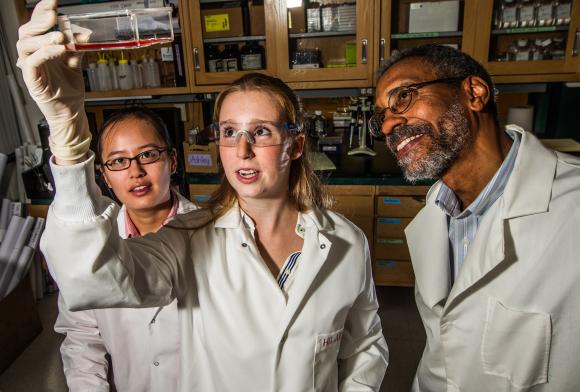 Science Cheerleaders are current and former NBA, NFL, and college cheerleaders pursuing STEM careers. We are thrilled to feature one of our directors, Hilary Nicholson, for her breakthrough research advancing a new treatment for kidney cancer! Read all about it in Science Signaling.
Science Cheerleaders are current and former NBA, NFL, and college cheerleaders pursuing STEM careers. We are thrilled to feature one of our directors, Hilary Nicholson, for her breakthrough research advancing a new treatment for kidney cancer! Read all about it in Science Signaling.
Former NFL and NBA cheerleader and Science Cheerleader Wendy (who’s also doing some pretty fascinating research) interviewed Hilary about her most recent accomplishment:
Wendy: Hilary, please briefly explain your research and its impact to society.
Hilary: My research focuses on trying to selectively kill cancer cells while sparing the rest of the healthy cells in the body. We do this by trying to take advantage of the mutations that cancer has to find context-specific targets (we call this “synthetic lethality”). This means that we try to find a target that only kills cells that have a particular mutation. My most recent study identified a target called CDK4/6 that could be used to kill cells that have a mutation is a particular gene called VHL. VHL is mutated in ~90% of clear cell renal cell carcinomas, which is the most common type of kidney cancer. We showed that we could use CDK4/6 as a target to kill cells that have mutations in VHL “in vitro” (which means in immortal cancer cell lines, in Petri dishes) and we could stop tumor growth in vivo (which means in a living organism) using the CDK4/6 target. Our work opens up a new potential way to treat patients with kidney cancer.
Wendy: Why is it important to publish results?
Hilary: In scientific research, we are all trying to understand the world better than we understand it now. We all want to discover new things! In cancer research, we all have the same goal of helping patients who have cancer. We try to understand why cancer happens, how we can treat it, and how it can be cured. It’s a big challenge, and it takes lots of very devoted people putting their heads together in order to make a difference. When we publish papers like the one that describes my most recent work, we try to write so that other people in the scientific community can learn from our studies to help move their own research forward and to help others understand what we have learned about the systems we work on. Papers like this help our colleagues and fellow scientists build on our results, and also to show them new tools we have developed that may help their work, too.
It’s always important to keep in mind who your audience is when you publish anything. My recent paper is written for other scientists, so it uses very specific language that is helpful in our field. However, my paper is not easy to understand if the cancer research field is new to you! If I were writing for a more general audience, I would try to use language that is more accessible to a broader audience. Publishing is only helpful if your intended audience understands what you’re trying to explain, so it’s very important to think carefully about who you’re writing for when you start to write. I recently spoke at a STEM Communication summer camp, and we went over the importance of knowing your audience and writing clearly for your intended reader. My intended reader for my recent paper was a scientist, and you can imagine it would look very different if it were written to be understood by a lawyer, or a politician, or a friend.
Wendy: How many women do you work with at your level and in your field? What can we do to support women to achieve your career level and support those at a similar position to continue to be successful?
Hilary: There are two other female postdoctoral fellows out of twelve fellows in my lab right now. I’m lucky to work in a lab where my colleagues are supportive of one another and we are all very collaborative, so it’s a nice environment. One of my colleagues refers to science as a “team sport”, and I really like that analogy. We all get further when we work together, and problems get solved faster and more creatively when you have multiple smart people coming at them with diverse points of views and backgrounds.
My boss (called the “Principal Investigator” or “PI”) pushes us all to do the very best science we possibly can, and to become the most skilled scientists we can be. He chooses the people who are invited to join the lab carefully to preserve the collaborative environment that we have. We all work very hard, and in the end we’re all in the lab because we believe we can make a difference through our research. Having different people work together, whether it’s people of different genders, different cultures, or different specialties, helps us all because we each bring something unique to the table. It’s the “team sport” mentality that allows us to have breakthroughs that no one person could achieve alone.
In order to support women in scientific research it’s very important to make sure that everyone feels like their contributions are valued and taken equally seriously. Women have a tendency to speak up less frequently in groups, particularly in groups that are male-dominated. That’s very often the case in scientific research. I believe that the more women feel like their voices and ideas are valuable, the more comfortable they will feel speaking up. And that’s something we will all benefit from, because a woman who otherwise would have stayed silent might instead bring a point of view that may be different and might help solve a problem by looking at it in a new way. We need all the ideas we can get in scientific research!
Encouraging women to stay in scientific research has additional issues, and the progression from student to scientist is often referred to as a “leaky pipeline” for women. It’s a very difficult problem to solve, but I think a great step in the right direction is for the environment to become more accepting of different working styles. Everyone has their own considerations within and outside of their careers, and traditionally women have sacrificed their careers for their families or in favor of their spouse’s career. Thankfully, more and more women have the option to choose what their professional lives will look like and how they want to find balance, but I think that the more receptive the field can be to different approaches and the more flexible we can be with what a scientist’s priorities and schedule “should be”, the more women we will see staying involved in science long-term.
Being a scientist was not a job that was initially created with women in mind, so we need to adjust the mold and the expectations to be more inclusive for everyone. We need to recognize that just because someone works differently or chooses a different style doesn’t mean their approach is in any way inferior. If we all did things the same way, there would be no progress in science!
 We are very proud of Hilary for all she’s accomplished and for her unwavering commitment to support women in STEM. Hilary volunteers as one of Science Cheerleaders core directors where she manages our relations with NFL, NBA and college cheer teams, interviews new Science Cheerleaders, coordinates events, and continues to participate in a number of public events. Cheers to Hilary!!
We are very proud of Hilary for all she’s accomplished and for her unwavering commitment to support women in STEM. Hilary volunteers as one of Science Cheerleaders core directors where she manages our relations with NFL, NBA and college cheer teams, interviews new Science Cheerleaders, coordinates events, and continues to participate in a number of public events. Cheers to Hilary!!
